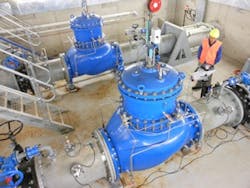Controlling Conditions Down Under
The North South Interconnection System Project (NSISP) is one of South Australian (SA) Water Corp.’s biggest infrastructure projects in the Adelaide metropolitan area. SA Water built the $403 million project to connect the north and south drinking water distribution systems and to increase access to a desalination plant. The project included the construction of 32 km of pipeline through metropolitan main roads and suburban inner streets.
Solution
To deliver this project, SA Water assembled an integrated project team comprising staff from a range of private-sector companies. A managing contractor framework was established to deliver the ancillaries program across the entire water network.
Several vendors proposed technical solutions to the project’s many phases. Control valves, in particular, were needed to perform in extreme conditions for several applications. The hurdles required a long consultation process to define the conditions and brainstorm solutions. In addition, quality, cost, serviceability and accessibility to equipment added more layers to the requirements.
Three major valve issues applied to all ten water stations. Each required different technology solutions.
• The valves need to work primarily on high-pressure drop conditions and occasionally at very low-pressure drop conditions. The danger of these conditions is that they can quickly lead to cavitation, which can be an extremely damaging force with loud noise, excessive vibration, choked flow and destruction and erosion of control valves and their components. This results in disruption of water distribution or plant shutdown. To deal with this problem, all the valves were fitted with Singer’s anti-cavitation technology, which contains two heavy stainless steel sliding cages that maximize the full flow capacity. The first cage directs and contains the cavitation recovery, allowing it to dissipate harmlessly; the second cage allows further control to a level as low as atmospheric pressure downstream. The cages are engineered to meet the flow/pressure differential of each individual application.
• Over the course of the distribution system, there would be a wide range of flow rate, from almost zero to maximum flow capacity. This is not uncommon in a distribution system, especially one of this scale, but when a valve is operating in the low flow range (less than 20% open), the valve can hunt and chatter. This causes noise, pulsing pressure waves downstream, and the constant open/close movement close to the seat can lead to premature wear. To overcome this challenge, each valve was equipped with Singer’s Single Rolling Diaphragm (SRD) technology. The SRD provides a constant surface area no matter the valve position and avoids injecting small pressure pulses into the piping. By doing this, the valve eliminates seat chatter at low flows, helping to prevent water loss and leakage while providing smooth, precisely controlled flow.
• With a city of 1.2 million people relying on this water distribution system, valve failure is simply not an option. Valve failure can occur in a number of ways. The most common is due to lack of maintenance on the pilot system strainer that eventually plugs, leaving the valve unable to close. Also, the primary pilot system can fail or plug for some simple reason and can halt operations. Finally, the main diaphragm can fail, which is extremely rare, but it can happen due to foreign objects traveling down the pipeline. By taking all these possibilities into account, the solution was to have the Northern P.R. Station’s PGM 2-by-24-in. main valve body installed with two independent diaphragms, allowing for full backup in the event that the primary system fails. This means the valve will continue to operate normally utilizing a secondary pilot system, whilst also giving an alarm signal that alerts operations to needed maintenance.
Results
By the time the project was completed, 23 valves with sizes ranging from 600 mm to 100 mm were installed at the ten different stations.
“All valves have been operating successfully, enabling SA Water to successfully transfer bulk water from the southern reservoirs and the desalination plant to the northern suburbs, securing water supplies to enable growth through to 2050,” said SA Water Project Director Mark Dedman.
